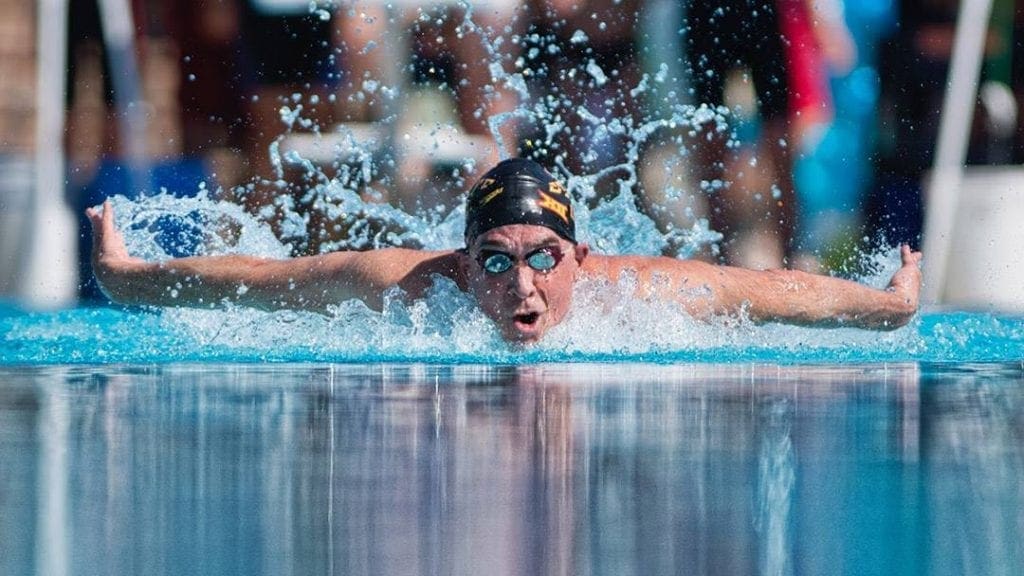Heart Surgery Keeps Trip Hedrick Swimming Strong

After a 20-year history of heart disease that’s included a heart attack and stent placements to clear blocked arteries, coronary bypass surgery at Mayo Clinic has helped Trip Hedrick continue pursuing his competitive swimming goals.
Looking at him and knowing his competitive swimming background, Clay “Trip” Hedrick seems to be about as far removed from the risk of heart disease as one can get. But the heart attack, stent procedures and coronary bypass surgery Trip has endured since 2000 are stark reminders that a healthy, strong body isn’t always enough to overcome some serious cardiac problems.
A
dedicated swimmer and former Iowa State University head men’s swimming coach, Trip’s
heart attack came when he was just 46, while he was in the pool. “I was
swimming by myself one day and was hit by a jolt of chest pain and radiating
arm pain,” he says. “I stopped and hung on to the side of the pool
for a while, thinking, ‘This is really weird.'”
So
weird, and so contradictory to the peak physical condition in which he kept his
body, Trip attributed the pain to a misstep in the weight room. “I dismissed
it,” he says. “I lifted weights a lot, so I thought maybe it was just
pectoral and triceps pain.”
Back in the water two days later, the pain returned. “I decided then that I needed a stress test, so I called my doctor,” Trip says. “I had it done the next day and passed with flying colors, but continued to have problems.”
Those problems eventually led Trip to drive himself to his local emergency department where an EKG revealed the true cause and seriousness of his chest pain. “They took me into the critical care unit and said: ‘You’ve had a heart attack. You have heart disease,'” he says. “I then had a stent placed because I had a 99% blockage of my left anterior descending artery — a widow-maker.”
Facing persistent problems
For
more than six years after Trip’s initial emergency department visit, the stent that
doctors placed in his clogged artery helped him continue the swimming he loved.
But his heart-related symptoms continued, too.
A friend who worked as a nurse at Mayo Clinic in Rochester thought Trip might be suffering from chronic hypertension and suggested he travel to Rochester for a complete workup and medical evaluation. Trip did just that. At first, he was placed under the care of Mayo Clinic vascular cardiologist Roger Shepherd, M.B., B.Ch. But after evaluating Trip, Dr. Shepherd referred him to fellow cardiologist Panithaya Chareonthaitawee, M.D.
“When
Trip initially came to us, his symptoms were subtle,” Dr. Chareonthaitawee
says. So subtle that extensive testing did not reveal any problems in need of
immediate attention. Then, in summer 2007, Trip experienced another bout of
chest pain while in the water, which led to another trip to the emergency
department and a second stent procedure to open an obscure blockage.
“Because he was training at such a high level, it was initially hard to identify a problem using the usual means we have.”
Panithaya Chareonthaitawee, M.D.
After that second stent was placed, Trip was once again back to competitive swimming. Eight years later, however, it was déjà vu all over again when he noticed shortness of breath while doing routine tasks around the house. He returned to Mayo Clinic and Dr. Chareonthaitawee.
“Because
he was training at such a high level, it was initially hard to identify a
problem using the usual means we have,” Dr. Chareonthaitawee says. “But
by listening to his story very closely, I was able to identify that even though
his symptoms were super subtle, there was an issue. We then did more testing
and were able to find that he had another severe blockage in one of his
coronary arteries.”
That
finding resulted in Trip having a third stent placed to clear another blocked coronary
artery.
Reaching new heights
Placement
of the third stent seemed to do the trick. Two years later, Trip set a new
world record in the 50-meter butterfly for men ages 60-64. Later that same
year, Trip was scheduled for a follow-up exam and a treadmill stress imaging test
with Dr. Chareonthaitawee, but he had to put it off after he tore a calf muscle
while training. A few months later, with his calf healed, he returned to Mayo
Clinic to complete that exam and stress test, expecting to pass with flying
colors.
After
reviewing his test results, however, Dr. Chareonthaitawee delivered the
sobering truth. Trip had developed yet another coronary blockage. And this
time, stenting wasn’t an option. What was an option — likely the best and only
option left –— was for Trip to undergo coronary bypass surgery. But Dr. Chareonthaitawee
had concerns about what bypass surgery could do to his active, swimming-filled
lifestyle.
“He
works so hard and is very dedicated to his swimming,” she says.
“Because of that, I was a little worried when I referred him to have
bypass surgery. I was afraid that a sternotomy would not allow him to have the
same swimming strokes he did before. We talked quite a bit about that before
the surgery because I know that swimming is a huge part of his life.”
If the coronary bypass surgery that John Stulak, M.D., a Mayo Clinic cardiovascular surgeon, performed on Trip had an effect on his swimming, though, it appears to have been negligible. Trip went on to set a new national record in the 50-meter butterfly for men 65-69 just 16 months after the procedure.
Today, Trip’s competitive swimming goals are even higher. Now he’s looking to set a new world record in the 50-meter butterfly for his age group — a feat that Trip and his improved heart hope to officially add to his resume during summer 2020. Until then, you can listen to Trip and Dr. Stulak talk more about his comeback from heart disease in this Mayo Clinic Radio interview:
HELPFUL LINKS
- Read about the symptoms and causes of heart disease.
- Check out the departments of Cardiovascular Medicine and Cardiovascular Surgery.
- Connect with other talking about heart health on Mayo Clinic Connect.
- Explore Mayo Clinic.
- Request an appointment.
